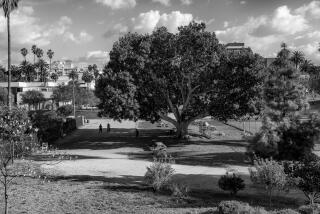A Tall Order for Rockefeller Center
- Share via
Wanted: Suspect is tall, heavy build. Norwegian. Could be anywhere in country. If you have any information, please call Rockefeller Center in New York City.
By car. By helicopter. David Murbach is searching everywhere from Boston to Kansas City. “I’m always looking,” he says of his obsession. “On weekend trips to the beach, business trips to the Midwest, I always have my eye out.”
Sometimes Murbach thinks he’ll never find what he’s looking for: the perfect Christmas tree.
As manager of the gardens division for Rockefeller Center for the last 17 years, it is Murbach’s job to locate the tree that will stand sentinel in the center each holiday season.
He can’t go to a tree farm, because the Rockefeller Center tree has to be at least 10 times taller than your average Christmas tree: 65 to 90 feet high. It can take almost a century for a tree to grow that tall. That limits Murbach’s search to one kind of tree: the Norwegian spruce.
“That’s a relatively fast-growing tree,” he explains. “It grows about a foot a year.”
But he also can’t look in forests, because forest trees are packed too densely to grow full and wide, the way they like them in Rockefeller Center. The Rockefeller tree has to be 35 feet wide “and so dense you can’t see through it,” Murbach says. It also must weigh about 7 tons.
So Murbach focuses his search on small old towns that are likely to have old trees, which generally means New England. Murbach’s “Big Three” states, which provide the most trees, are New York, New Jersey and Connecticut.
Murbach begins his search by air, flying over towns in a helicopter, peeping in people’s backyards hoping to spot his prey. When he sees a potential candidate, he moves in by car, then approaches the owners.
“I walk in and people can’t believe I’m from Rockefeller Center,” he says. “They think it’s a joke.”
Murbach doesn’t buy the tree, although the center pays for cutting it, moving it and redoing the owner’s yard. “If a person says no, I just continue my search,” he says. “But most people agree to donate their tree because it’s such an honor.” The donors are brought to New York for the tree-lighting ceremony.
Getting the tree down is a technical feat. Telephone poles and lines frequently have to be moved to make way. Once down, the tree is placed in a specially designed 100-foot-long tractor-trailer and driven to New York in the dead of night to avoid disrupting traffic.
Once at Rockefeller Center, the 4-foot-tall star is bolted onto the tree first, while it is still on its side. Once the tree is raised, seven stories of scaffolding are built around it so that it can be decorated. It takes 2 1/2 weeks and 25 electricians to get the 26,000 lights on and lit.
This year’s 81-foot spruce is decked in nearly five miles of red, white and blue lights. The 71-year-old tree came from the backyard of Andrew and Kelly Tornabene in Wayne, N.J.
Half a million people visit the tree every day during the holiday season. It is removed a week after New Year’s Day.
After it is brought down, the tree is hacked up for its parts. The foliage is donated to the Boy Scouts of America, who chip it into three tons of mulch for use on nature trails. The tree’s trunk is used by the U.S. Equestrian Team for jumps at the Essex Horse Trails. Then--the new search starts.
Murbach begins his hunt on pins and needles every year. “I always wonder if there is one more tree out there,” he says. “We always have a really hard time finding one.”
If you think you might have a Norwegian spruce for Rockefeller Center, Murbach says you should send him a photo. But it has to be perfect all around. “People think you can turn the bad side to the wall,” he says. “But we don’t have a wall.”
More to Read
Sign up for Essential California
The most important California stories and recommendations in your inbox every morning.
You may occasionally receive promotional content from the Los Angeles Times.













